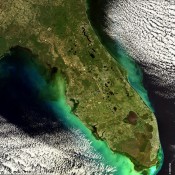15 December 2011 | In a dramatic reversal of stated policy, the US Environmental Protection Agency (EPA) has called off its push for federally-imposed numeric water quality standards for Florida waterbodies, and instead gave a preliminary blessing to standards developed by state officials.
The spar between state and federal officials in Florida over who gets to set standards has been watched closely by other states and environmental groups. The EPA’s
2010 Final Rule introduced statewide quantitative nutrient limits to replace existing narrative, or qualitative, criteria. The Rule was upheld by a district judge in April who sided with the EPA that Florida authorities had failed to protect the state’s waters.
But in a
November 2nd letter, EPA Acting Assistant Administrator Nancy Stoner indicated that the agency would withdraw its own controversial guidelines pending the approval of new state rules developed by Florida’s Department of Environmental Protection. State standards
were approved last week by the Florida Environmental Regulation Commission and now go to the legislature. In other words, state control over water quality criteria is looking like a done deal.
The debate in Florida is important to water quality market advocates, since earlier this year it looked like the EPA was willing to bring down the hammer in order to ensure that all states had quantitative water quality standards. Having numeric criteria in place is one less hurdle for water quality trading and other payment mechanisms, since it can act as a de facto cap to drive market demand. The Final Rule also suggested that if a state failed to clean up its waters, the EPA just might do it for them.
Florida remains the only state where EPA has sought to impose standards – normally these are set by states. In that sense, the Final Rule was understood by opponents and supporters alike as an important precedent for federal oversight of state water quality standards.
Weaker federal role = Weaker standards?
The new DEP-developed rules are also numeric,
but less strict on several fronts. Florida authorities will create a new sub-category, “Class III-Limited.” If regulators think that water quality goals can’t be met cost-effectively, the Class III-Limited category effectively allows them to lower the standards for a waterbody. It’s a departure from federal law that aims at maintaining or improving water quality – not downgrading it. Florida officials say they’ll only use the special designation for man-made canals and other waterways where there isn’t a threat to natural ecosystems, though the EPA has granted state officials considerable leeway in granting Class III-Limited status.
The Bottom Line
It’s mixed news for water quality markets. Numeric standards that can act as ‘caps’ are an essential foundation for trading. Of course, if those standards are relatively lax, there’s little demand for trading since the regulated entities can easily meet their obligations; there’s no need to search out the most cost-effective strategy for cleanup.
Indeed, most of the resistance to the tougher EPA standards centered on their projected costs of implementation – which varied widely depending on who was crunching the numbers. The EPA pegged compliance with federal guidelines at between $135 and $206 million. A consultancy hired by industry and utility groups estimated costs at over $4 billion.
Additional resources


